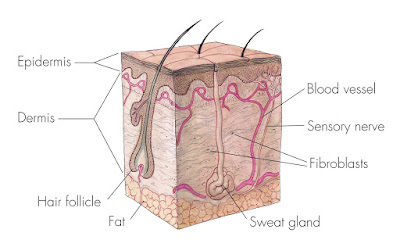Skincare Basics: Layers & Functioning of the Skin
January 19, 2016
Skin is the your body's largest organ which covers and protects every surface of our body.
It is very important to know how your skin functions because it gives you insight about how you should care for your own skin and tend to its needs.
You just can't ignore your skin for months and years and compensate for it with expensive treatments, you should take care of your skin regularly and inculcate it in your daily routine to have clear, soft and supple skin.
These tiny organs open into hair follicles on the surface of the skin and produce an
These glands are located on the scalp, face, cheeks and the T-zone.
(ii) Sweat Glands
There are millions of sweat glands located all over our body and their main function
Hairs grow out of the hair follicles and keep the body warm by trapping air
Functions of Skin
The condition of your skin is an overall sign of your health. It reveals stress, a poor diet, lack of sleep, substance abuse and more. To take good care of your skin, the knowledge of its structure and functioning is very important to know exactly how to get the perfect skin.
It is very important to know how your skin functions because it gives you insight about how you should care for your own skin and tend to its needs.
You just can't ignore your skin for months and years and compensate for it with expensive treatments, you should take care of your skin regularly and inculcate it in your daily routine to have clear, soft and supple skin.
Layers of Skin
The skin is composed of two main layers; mainly the Epidermis and the Dermis.
Epidermis
- The epidermis is the top most layer of skin and it protects the body from invasion and infection from the outside world and helps seal in the natural moisture of the skin.
- Several layers of living cells in this layer are covered by sheets of dead cells, which make up the visible part of our skin.
- The epidermis layer is constantly growing, with new cells living cells being created and dead top-most cells being shed continuously.
- Low levels of skin cells, or the living skin cells are fed by the blood supply and the upper/ surface level of cells, or the dead cells a require only water to be plump and smooth.
- The epidermis layer is responsible for the colour of your skin as it holds the skin's pigments.
- The thickness of the epidermis layer depends upon the part of the body, epidermis is thicker on the ankles, elbows, etc. but is thinner around the eyes.
Dermis
- The dermis layer of the skin is located underneath the dermis layer and is composed entirely of living skin cells, unlike the epidermis.
- It consists of bundles of tough fibers which gives the skin its elasticity, firmness and strength.
- Blood vessels feed nutrients to the skin cells in the dermis layer.
- The epidermis can easily repair and restore itself, but the dermis layer can be damaged permanently upon injury.
- The dermis layer consists of the following specialized organs:
These tiny organs open into hair follicles on the surface of the skin and produce an
oily secretion called the sebum which is the skin's natural lubricant.
These glands are located on the scalp, face, cheeks and the T-zone.
(ii) Sweat Glands
There are millions of sweat glands located all over our body and their main function
is to regulate the temperature of the skin.
(iii) Hairs
Hairs grow out of the hair follicles and keep the body warm by trapping air
underneath them.
Functions of Skin
The skin has the following functions:
1. Thermostat
The skin acts as a thermostat by retaining heat via the hairs on the skin and by cooling down the skin by sweating.
2. Protection
The skin protects us from invasion and infection from the outside world.
3. Waste disposal
Certain wastes are expelled from the body 24 hours a day via the skin.
4. Sensation
It provides us with the sense of touch, which is important during non-verbal communications with people and the environment.
5. Healing
The skin heals and renews itself.
6. Barometer for emotions
Skin quickly shows signs of stress and embarrassment.
The condition of your skin is an overall sign of your health. It reveals stress, a poor diet, lack of sleep, substance abuse and more. To take good care of your skin, the knowledge of its structure and functioning is very important to know exactly how to get the perfect skin.















4 comments
Interesting post!
ReplyDeleteAlice Cerea,
Alice Cerea Blog
Thank you so much :)
DeleteI was a science major and remember studying this in human anatomy etc. This made me smile. Yes, definitely one of the largest organs. Take care of it.
ReplyDeletehttp://www.averysweetblog.com/
Aah! And that's the reason to you're beautiful, flawless skin!
DeleteHello there!
I hope you're having a good day.. Do leave a comment..
Follow La Belle Dame on bloglovin and I'll follow yours right back!
Xoxo